沪教版七上U6教案
- 格式:doc
- 大小:38.50 KB
- 文档页数:8

2021学年沪教版牛津英语七年级初一 Unit 6 教案一、回顾:核对5作业、听写单词二、教学目标:现在进行时用法三、单词peaceful adj.平静的 peace n.和平;平静 peacefully adv.和平地;平静地convenient adj.方便的 convenience n.方便(不可数)neighbourhood n.街区;城区neighbour n.邻居;邻国bottom n.底部 at the bottom of在……的底部 at the top of 在……的顶部step n.台阶;步伐;足迹 steep adj. 陡的noisy adj.吵闹的;嘈杂的noise n.噪音(不可数) make noise制造噪音excite v.使激动;使兴奋 exciting adj. 令人激动的;使人兴奋的please v.使高兴 pleased adj.高兴的;愉快的 pleasant adj. 令人愉快的relax v.放松;缓和 relaxing adj. 令人放松的 relaxation n.放松;消遣;娱乐financial adj. 金融的;财政的 finance n.金融;财政 financial centre金融中心church n.教堂 go to church 去教堂做礼拜 go to the church 去教堂 go shopping 去购物statue n.雕塑;雕像 fountain n. 喷泉exhibition centre展览中心restaurant餐馆swimming pool游泳池 bank银行 supermarket超市post office 邮政局 cinema电影院beach沙滩(复-es)kindergarten 幼儿园hospital医院glove n. 手套(复-s)storybook n.儿童故事书;童话书take … to …乘……到…… move to …搬到某处 live in …居住在某处四、语法:1.It takes about forty minutes.大概需要花费40分钟某人花了多少时间做某事It takes sb some time to do sth=sb spends some time (in)doing sth2.句子成分划分Is it convenient to go shopping in your new neighbourhood?你们新街区购物方便吗?It is +adj.+to do sth (做某事)很(怎么样)it形式主语 to do sth真实主语(v-ing也可以做真实主语)Learning French is difficult.When we lived in the city centre,we got up late and walked to school.when是时间状语从句,可以位于主句前,也可以位于主句后。
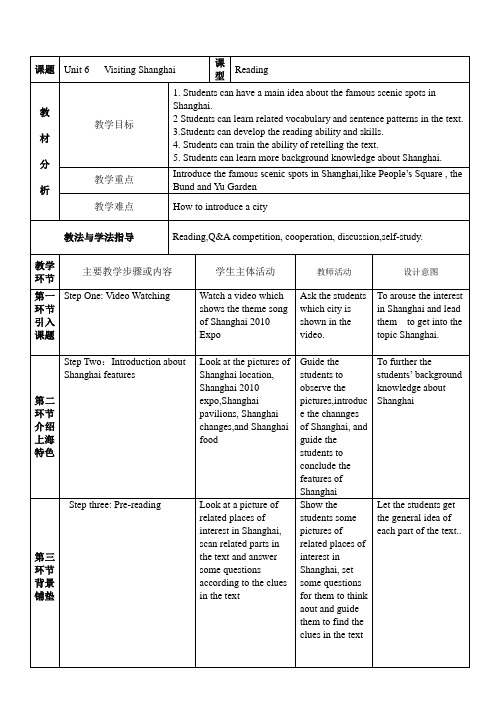
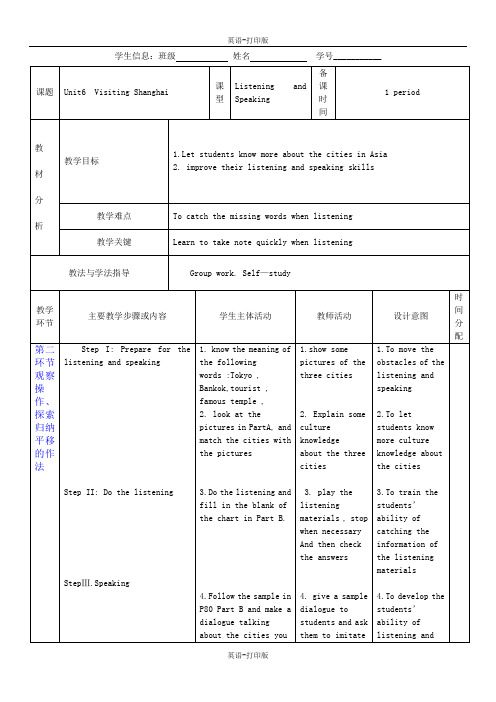
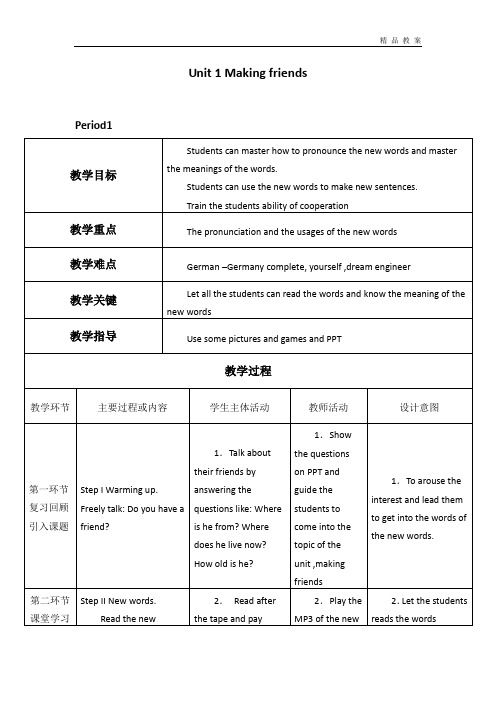
Unit 1 Making friends Period1Unit 1 Making friends Period2Unit1 Making friends Period3Unit 1 Making friends Period4Unir1 Making friends Period5Unit1 Making friends Period6Unit 2 Daily life【教学目标】1.学生能够正确理解和朗读课文。
2.学生能够听、说、读、写本课单词。
3.学生能够理解和运用一般现在时。
4.能够清晰地描述自己的日常生活。
【教学重难点】1.学生能够理解和运用一般现在时。
2.能够清晰地描述自己的日常生活。
【教学准备】录音机,磁带,英语书,PPT【教学过程】Step 1 GreetingsStep 2 Warming up1.Getting readyWhat do you do every day?2.ReadingLook at Part A and answer the questions in Part A.Look at Part B and answer the questions in Part B.Check the answers.Finish the exercises in Part C and D.Check the answers.3.Listening and SpeakingFirst,just listen for the first time. Do the exercises in this part. Check theanswers.Speaking.注意/s/ /z/和/iz/d的正确发音。
T alk about one’s daily life.4.GrammarWork out the rule.Do the exercises in this part.Check the answers.5.WritingRead Fang Fang’s daily schedule below and complete the article about herlife.Finish a daily life of your own.Step 3 Key points Explanation.1.brush one’s teeth刷牙watch television= watch TV 看电视play table tennis 打乒乓ride a bicycle 骑单车play the piano 弹钢琴wash my clothes= do some washing 洗衣服2.a day at school 学校的一天by Sam:由Sam写的at school 在上学at the school在学校(可能是老师或家长)in hospital生病住院in the hospital在医院(可能是护士或家属)in bed卧病在床;躺在床上in the bed在床上(被窝里);on the bed在床上(如枕头)3.I am a junior high school student. I love going to school.junior high school 初中senior high school 高中primary school 小学love doing sth.= like doing sth. = enjoy doing sth.喜欢做某事practice doing sth.练习做某事finish doing sth. 做完某事go to school 去上学4.My school is close to my home,so I always go to school on foot.be close to 离……近= near =beside= not far away fromfamily 的意思是“家庭、家庭成员”,与居住的房子无关.当family作为整体概念的“家庭”讲时是单数;当“家庭成员”讲时是复数;house 指“家”时含义较窄,仅指“房屋”这一建筑物,一般指独门独户的房子,不指楼房;home 指“家、住所”,指一个人(或一家人)居住的地方,也可指一个人出生或长大的地方(乡村、城市或国家等).它具有house所没有的感情色彩go to school on foot= walk to school步行去学校go to…on foot = walk to …5.Classes start at 8 am,and I am seldom late.start at几点开始be late迟到be late for school 上学迟到6.I enjoy learning about different places in the world.enjoy doing sth= like/love doing sth. very much 喜欢做某事learn about获悉;了解different places in the world世界各地7.We have our morning break at 9:50.have one’s morning break上午休息时间have a break 课间休息have a rest 休息一会8.When the bell rings,I run to the playground with my best friends Tom and Jack.when当……的时候此处连接两个先后发生的动作;也可表示两个动作同时发生,则:“过去进行时+ when+ 一般过去时”;另外,when也可对时间提问,“何时”run to…with s B.和某人一起跑到…… my best friends:我最好的朋友们9.Break ends at 10:10. How Short it is!end at ……时间结束how+ adj. (+主+谓) = what+ (a/an) + adj.+ n. (+主+谓)how 主要修饰形容词和副词,what修饰名词.How short it is! = What short time it is!10. Lunch is from 11:50 to 12:30 p.m.from…to… 从……到…… from Monday to Friday11.Then Tom,Jack and I take part in the school band practice.take part in:参加,指参加会议或群众性活动等,着重说明句子主语参加该项活动并在活动中发挥作用;join指加入某个党派,团体组织等,成为其成员之一,意为:“参军、入团、入党”等;和某人一道做某事,其结构为:join sb.in (doing) sth.,根据上下文,in (doing) sth.也可以省去(join in多指参加小规模的活动如“球赛、游戏”等,常用于日常口语);attend是正式用语,指参加会议、婚礼、典礼;听报告、讲座等.He'll attend an important meeting tomorrow.他明天要参加一个重要会议band乐队the school band practice学校乐队练习practice名词:练习eg:Learning a language needs a lot of practice.动词:练习practice doing sth.. practice sth.practice the violin practice playing the pianopractice 实习,实践,指有规律的练习,特指反复练习,不断练习,如大音乐家需要不断的practice.exercise是练习,一般用语,可指训练,锻炼,操练等.如spelling exercise(拼写练习),,lack of exercise缺乏练习,do one's exercise做练习,physical exercise 体育锻炼exercise的用法:1.作可数名词用,“练习,习题,体操,功课,操练”等,常用复数。
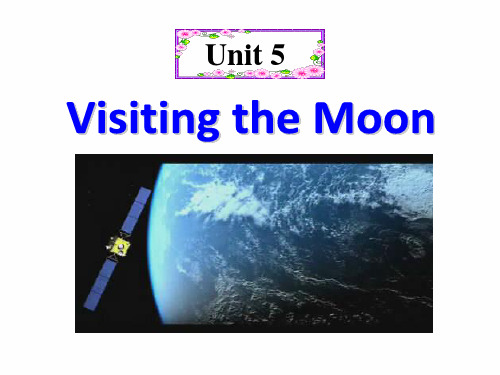
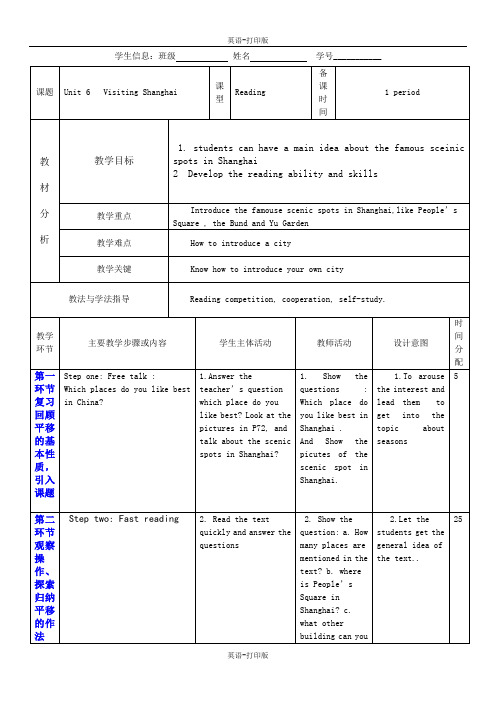
牛津上海版英语七年级上册《Unit 6 Different places》教学设计6一. 教材分析牛津上海版英语七年级上册《Unit 6 Different places》是针对我国七年级学生编写的一篇英语教材。
本单元主要讨论了不同地方的话题,通过学习,学生可以了解到世界各地的风景名胜、文化习俗等。
教材内容丰富,插图生动,旨在激发学生的学习兴趣,提高他们的英语听说读写能力。
本节课的教学设计将围绕教材内容,结合学生的实际情况,设计一系列有针对性的教学活动。
二. 学情分析七年级的学生具有较强的学习兴趣和好奇心,但英语听说读写能力参差不齐。
在《Unit 6 Different places》的教学中,学生需要掌握各地的名胜古迹、风土人情等词汇,并能运用所学知识进行简单的交流。
因此,在教学过程中,教师要关注学生的个体差异,尽量让每个学生都能参与到课堂活动中来,提高他们的英语水平。
三. 教学目标1.知识目标:学生能够掌握本节课的生词和短语,了解世界各地的风景名胜和文化习俗。
2.能力目标:学生能够用英语简单介绍自己喜欢的旅游目的地,提高他们的英语口语表达能力。
3.情感目标:通过学习,学生能够培养对不同文化的尊重和理解,增强他们的跨文化交际意识。
四. 教学重难点1.重点:学生能够掌握本节课的生词和短语,正确运用所学知识进行交流。
2.难点:学生能够用英语介绍自己喜欢的旅游目的地,表达清楚、准确。
五. 教学方法1.任务型教学法:通过设计各种任务,让学生在实践中运用英语,提高他们的语言能力。
2.情境教学法:创设真实的语境,让学生在具体的情境中学习英语,增强他们的学习兴趣。
3.合作学习法:鼓励学生分组合作,进行交流讨论,提高他们的团队协作能力。
六. 教学准备1.教师准备:提前准备好教材、课件、图片等教学资源,熟悉教学内容。
2.学生准备:学生预习教材,了解本节课的学习内容。
七. 教学过程1.导入(5分钟)教师通过展示世界各地的风景图片,引导学生谈论自己喜欢的旅游目的地,激发学生的学习兴趣。
初一英语上册同步学案Unit 6Warm-up: ReadingGuangzhou is a nice city. The weather changes from season to season. Now many tall buildings have been set up one after another. But at the same time, the city is full of people. As a result, the traffic is terrible. Traffic jams happen during the rush hours. If you want to go to place in far away, the fastest way is nether driving, nor riding a bike. It is often walking! The policemen in Guangzhou are very helpful. Visitors can turn to them for help if they lose their way or lose something. You are welcome to Guangzhou.一、复习展示more than 能够 不得不把......系在 so that 变得虚弱 帮助某人做某事 在月球上 拍照 对......感到兴奋_______________ 带回___________________ such as______________在学校门口__________________ at the moment_____________ a large amount of___________二、知识探究1. Shanghai is one of the largest cities in the world.上海是世界上最大的城市之一。
---------------------------------------------------------------最新资料推荐------------------------------------------------------沪教版七上U6教案1TravellingaroundAsia1.travelguide 意为旅游手册可以简称为guide。
Ineedatravelguide.我需要一本旅游手册。
Atravelguideisimportantforyou.一本旅游手册对你很重要。
guide 可数名词,意为手册;指南Iwillbuyaguidefortravellers.我将买一本旅游指南。
拓展 guide 的用法;1.可数名词,意为导游 Hewantstobeaguide.他想成为一名导游。
2.及物动词,意为引领参观Sheguidesthetouristsaroundthecity. 她引领着游客游览这个城市。
名词,意为亚洲。
InAsia 意为在亚洲 ChinaisinEastAsia.中国在东亚。
拓展 Asia 的用法;1.形容词,意为亚洲的;亚洲人的 2.可数名词,意为亚洲人 WeareanAsiancountry.WeareAsians.中国是一个亚洲国家,我们是亚洲人。
3.placeofinterest 意为名胜,其中 interest 在此处用作不可数名词,place 是可数名词。
TherearemanyplacesofinterestinChina.中国有很多名胜。
1 / 8TheGreatWallisaplaceofinterest.长城是一处名胜。
4.bemadein+地点意为产于某地, MypianoismadeinBeijing. 我的钢琴是在北京制造的。
1.bemadeby+人意为被某人制造 Thetableismadebyworkers.这张桌子是由工人建造的。
2.bemadeof 意为,由.....制成,从制成品能看出原材料。
Thetableismadeofwood.这张桌子是木制的。
3.bemadefrom 意为,由......制成。
从制成品看不出原材料。
Wineismadefromgrapes.红酒是葡萄做的。
4.bemadeinto 意为制成,into 后接制成品Grapesaremadeintowine.葡萄被酿成了酒。
5.oneof(+the+形容词最高级)+复数名词/代词意为(最).....之一,作主语时,谓语动词用单数形式。
Tomisoneofthetallestboysinourclass.汤姆是我们班个子最高的男生之一。
Oneofushasatravelguide.我们中的一个有旅游手册。
6.sightseeing 合成名词,意为观光;游览。
Thesightseeingwilllastaboutonemonth.这次观光大约会持续一个月的时间。
gosightseeing 去观光dosomesightseeing 游览Whydoyougosightseeing?你为什么去观光?---------------------------------------------------------------最新资料推荐------------------------------------------------------ Weregoingtodosomesightseeingbecausewelikeitsculture.我们打算去游览,因为我们喜欢它的文化。
7.inthecenterof 在....中央=inthemiddleof centre 名词,意为中心点,中心,强调的是一个点,习惯上指空间的中央,如圆,球体,靶子的正中心;另外,center 还可以表示中心区,中心站或重要活动的中心。
Thehotelisrightinthecenterofthevillage.这家旅馆在村子的正中央。
Thatisashoppingceter.那是一个购物中心。
Central 形容词,意为中心的,中央的。
Therailroadstationisinthecentralpartofthecity.火车站在该市的中心。
8.area 可数名词,意为区域;地区。
2 Theywillbuildagardeninthisarea.他们将在这个区域内建一个花语是你。
Insomearea,childrenwalktoschool.在有些地区,孩子们步行去上学。
area 作名词,还可意为面积。
anareaof100squaremetres.9.building 可数名词,意为建筑(物) Therearetwoteachingbuildinginourschool.在我们学校有两座教学楼。
3 / 8build 及物动词,意为建造,建造。
Theywillbuildmanybuildingsinthecity.他们要在这个城市建很多楼房。
10.just 副词,意为正好,恰好,常用于肯定句中。
ThatsjustwhatIwanted.那正是我想要的。
Itsjustsevenoclock.正好七点。
11.across 介词,意为在....对面。
acrossfrom 意为在....对面。
TheSmithlivejustacrosstheriver. 史密斯一家住在河对面。
Theyliveacrossfromus.他们住在我们河对面。
Across 作介词,还有穿过,横过之意,着重指从物体表面的一边到另一边。
Dontwalk acrosstheroad.不要横穿马路。
12.light 动词,意为照亮;使明亮。
lightup 点亮;照亮。
Sunlightlightsherface.阳光使他的脸明亮起来。
Firelightsuptheroom.火光照亮了房间。
light1.名词,意为光,光线。
Dontreadinthebadlight.不要在光线不好的地方读书。
2.形容词,意为轻的;浅色的;明亮的 lightmusic 轻音乐lightgreen 淡绿色alightclassroom 明亮的教室13.direction 可数名词,意为方向。
---------------------------------------------------------------最新资料推荐------------------------------------------------------ inalldirections=ineverydirection.四面八方14.traditional 形容词,意为传统的,可在句中作定语或表语。
DumplingsaretraditionalfoodinChina.在中国,水饺是传统的美食。
15.natural 形容词,意为自然的,天然的。
Therearemanyplantsinthenaturalworld.在自然界中有很多植物。
Wealllikenaturalbeauty.我们都喜欢自然美。
nature 名词,意为自然,自然界。
NatureisthemostbeautifulinSpring.自然界是在春天是最美的。
16.beauty 名词美;美丽 Hangzhouisacityofgreatbeauty.杭州是一个非常美丽的城市。
它还有美人的意思,美的东西之意。
Sheisabeauty.她是个美人。
beautiful 美丽的;漂亮的 Jennyisabeautifulgirl.珍妮是一个漂亮的女孩。
17.outside 介词,意为在.....外面,由out+side构成,反义词inside(在.....里面) Hegoesoutsidethehouse.他走出屋外。
1.用作副词,意为在外面。
Letsgooutsidetodosomeoutdooractivities.让我们出去做一5 / 8些户外活动。
2.用作形容词,意为外面的Outsideworkedneedwarmclothesinwinter.在冬天,户外工作人员需要暖和的衣服。
3.用作名词,意为外部,外表。
Theoutsideofthehouseisred.这个房子的外表是红色的。
18.referto 提到;涉及;指的是。
WhenIsaythething,Idontrefertoyou.当我说这件事时,我不是针对你的。
Referto 还可意为参考;查阅.Youcantrefertoyournoteswhenyouareintheexam.考试时,你不能查阅笔记。
319.dumpling 名词,水饺,复数形式dumplings. Ilikeeatdumplings.我喜欢吃饺子。
20.Isometimesbringthewrongbookstoschool.我有时上学带错书.(教材 78) bring 及物动词,意为带来,是指把某物从别的地方带到说话的地方来。
Canyoubringyourphotostoschool?你能把你的照片带到学校来吗?辨析;bring,take 与 get.bring 意为带来;拿来取来指从别处把某人或某物带到或拿到说话者所在的地点take 意为带去;拿走; 和 bring 相反,指从说话者所在的地把某物带去或拿走get 意为去取(或带来) 指到别处去把某人请来,接来或把某物拿来,有去回双---------------------------------------------------------------最新资料推荐------------------------------------------------------ 程之意Mybooksareupstairs,Willyoubringthemdown?我的书在楼上,您可以把他们拿下来吗?Pleasetaketheseexercisesbookstotheteachersoffice.请把这些练习本送到老师的办公室去。
Waitamoment,please!Iwillgetacupofteaforyou.请稍等!我为你去倒杯茶。
21.Iwasawayfromschooltoday.我今天没去学校。
(课本第 78) beawayfrom 意为离开......,表示离开的状态。
Heisawayfromhome.他离家在外。
22.puton 穿上;戴上,它的反义词组是 takeoff,意为脱下。
这两个词都强调动作,不能用来表示状态。
Putonyourshoes,please.Letsgo.请穿上你的鞋子,我们走吧。
MrWangisputtingonhisglasses.王先生正在戴眼镜。